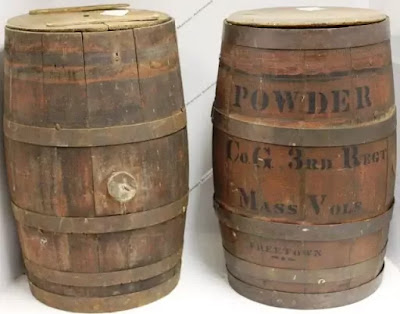Black powder was generally shipped in boxes (cases) or cylindrical containers. Barrels were used because they were designed to hold goods without risk of leakage and were used for centuries for this purpose. On the other hand, boxes are easier to stack on top of each other than barrels and waste less room.
The boxes were usually made of copper and had powder loaded in a linen bag, or they were made of wood (which was cheaper) and had a slightly smaller box inside, into which the powder was loaded. Boxes varied in size, depending on the country, the type of powder etc. For instance, in England, some cases were about 2 feet long, 2 feet wide and 6 inches high. In the Confederate States, their boxes were about one foot long, one foot wide and 2.5 feet long. In Austria, their boxes were big enough to contain about 64 lbs. of powder. For sea duty, the boxes were generally made of copper. While boxes cannot be rolled around easily like barrels, they can be packed together more tightly than barrels can, which is why some factories started to switch from barrels to boxes towards the end of the nineteenth century.
Containers generally came in multiple sizes: Barrels, Kegs and Canisters.
Barrels are generally the largest of these containers. Typical barrels of the nineteenth century were about 2 feet high and about 1 to 1.5 feet in diameter. Capacity of the barrels varied by country, but most could usually hold about 110-120 lbs. of powder. However, these barrels were usually only filled to about 90% of the capacity (e.g. they would only fill about 100 lbs. of powder to a barrel capable of holding 110 lbs.). This was done so that the powder would have room to move inside the barrel during transport and wouldn't get caked.
A stack of powder barrels made in England. Click on the image to enlarge.
Another stack of powder barrels. Click on the image to enlarge.
Most barrels would have a hole of about 1.5 to 2 inches diameter drilled to the top of the barrel, which would then be plugged with a wooden screw. This way, if someone wanted to access the powder inside the barrel, they only needed to remove the screw instead of the entire top of the barrel. A leather washer soaked in wax and turpentine would be placed under the screw head, which served to keep moisture out. The image below shows an example of this:
Notice the screw at the top of the barrel. Click on the image to enlarge.
Kegs were generally built on the same principle as barrels, but were much smaller in size, typically holding about 25 lbs. of powder. Also, instead of having an opening on top, most kegs had an opening in the middle to access the powder.
An example of a powder keg
Kegs are much easier to transport than barrels on account of their lesser weight and were favored in places where there wasn't much room to move around in (e.g. on board ships).
A couple of Civil War era powder kegs. Click on the image to enlarge.
Finally, we have canisters. Unlike barrels and kegs, these were generally made of metal and had the least capacity of the three container types.
A black powder canister. Click on the image to enlarge.
Powder canisters typically held about 0.5 to 1 lb. of powder. The above example is a canister made by the Eureka Powder Works of New Durham, New Hampshire. It is made of steel, is about 4.75 x 4 x 1.75 inches in size and has a paper covering on the outside with hunting scenes printed on it. Due to their small size and capacity, these are much lighter than the other containers we have studied above and are easy to transport. Unlike barrels and kegs, these were intended to be sold to private individuals rather than military units.






No comments:
Post a Comment